Page 485 of 576
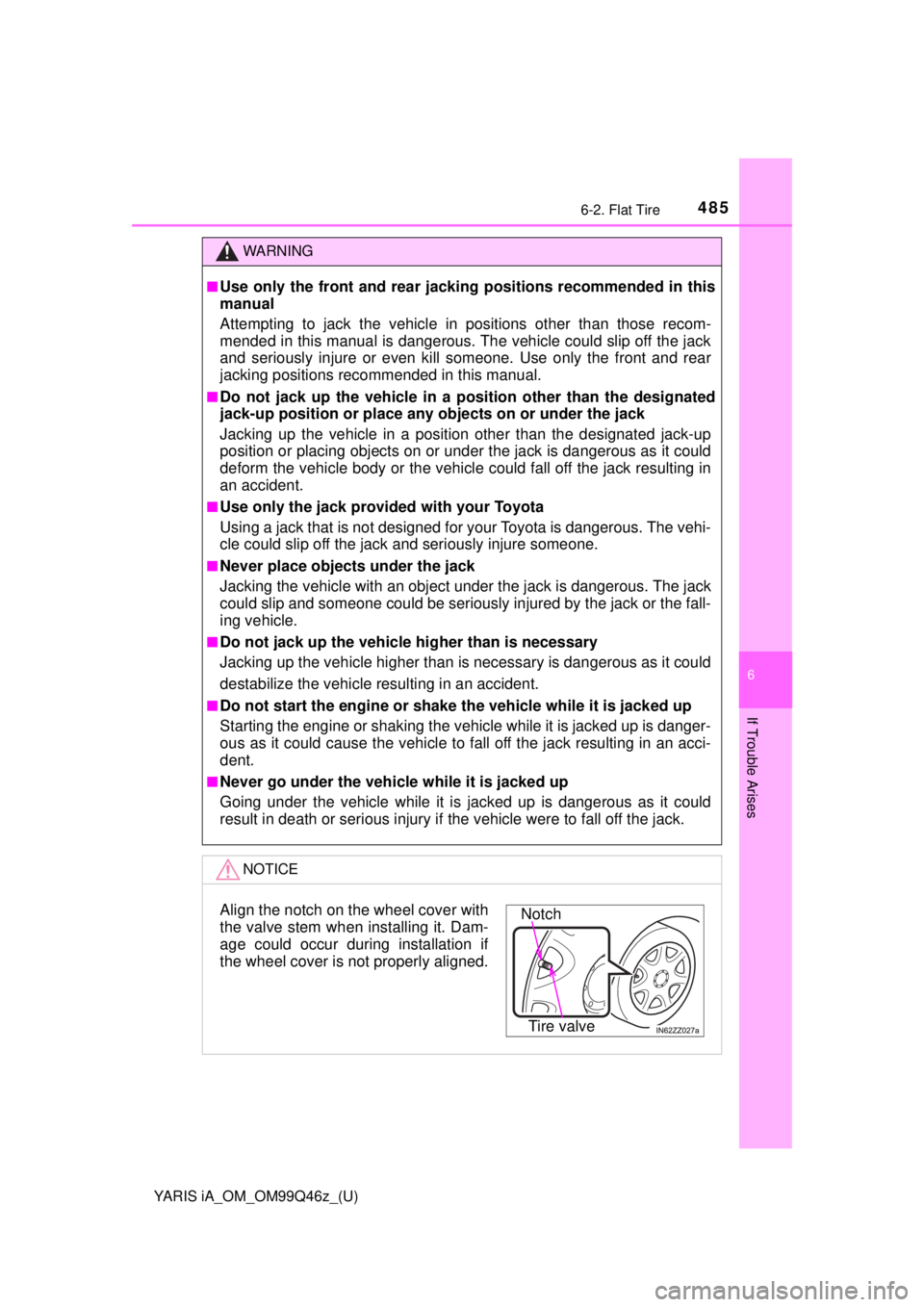
YARIS iA_OM_OM99Q46z_(U)
4856-2. Flat Tire
6
If Trouble Arises
WARNING
■Use only the front and rear jacking positions recommended in this
manual
Attempting to jack the vehicle in positions other than those recom-
mended in this manual is dangerous. The vehicle could slip off the jack
and seriously injure or even kill someone. Use only the front and rear
jacking positions recommended in this manual.
■Do not jack up the vehicle in a position other than the designated
jack-up position or place any objects on or under the jack
Jacking up the vehicle in a position other than the designated jack-up
position or placing objects on or under the jack is dangerous as it could
deform the vehicle body or the vehicle could fall off the jack resulting in
an accident.
■Use only the jack provided with your Toyota
Using a jack that is not designed for your Toyota is dangerous. The vehi-
cle could slip off the jack and seriously injure someone.
■Never place objects under the jack
Jacking the vehicle with an object under the jack is dangerous. The jack
could slip and someone could be seriously injured by the jack or the fall-
ing vehicle.
■Do not jack up the vehicle higher than is necessary
Jacking up the vehicle higher than is necessary is dangerous as it could
destabilize the vehicle resulting in an accident.
■Do not start the engine or shake the vehicle while it is jacked up
Starting the engine or shaking the vehicle while it is jacked up is danger-
ous as it could cause the vehicle to fa ll off the jack resulting in an acci-
dent.
■Never go under the vehicle while it is jacked up
Going under the vehicle while it is ja cked up is dangerous as it could
result in death or serious injury if the vehicle were to fall off the jack.
NOTICE
Align the notch on the wheel cover with
the valve stem when installing it. Dam-
age could occur during installation if
the wheel cover is not properly aligned.Notch
Tire valve
Page 490 of 576

4906-2. Flat Tire
YARIS iA_OM_OM99Q46z_(U)
WARNING
■Make sure the mounting surfaces of the wheel, hub and lug nuts
are clean before changing or replacing tires
When changing or replacing a tire, not removing dirt and grime from the
mounting surfaces of the wheel, hub and hub bolts is dangerous. The
lug nuts could loosen while driving a nd cause the tire to come off, result-
ing in an accident.
■Do not apply oil or grease to lug nuts and bolts and do not tighten
the lug nuts beyond the recommended tightening torque
Applying oil or grease to lug nuts and bolts is dangerous. The lug nuts
could loosen while driving and cause the tire to come off, resulting in an
accident. In addition, lug nuts and bolts could be damaged if tightened
more than necessary.
■Always securely and correctly tighten the lug nuts
Improperly or loosely tightened lug nuts are dangerous. The wheel
could wobble or come off. This could result in loss of vehicle control and
cause a serious accident.
■Be sure to reinstall the same nuts you removed or replace them
with metric nuts of the same configuration
Because the wheel studs and lug nuts on your Toyota have metric
threads, using a non-metric nut is dan gerous. On a metric stud, it would
not secure the wheel and would damage the stud, which could cause
the wheel to slip off and cause an accident.
■Do not drive with any tires that have incorrect air pressure
Driving on tires with incorrect air pressure is dangerous. Tires with
incorrect pressure could affect handling and result in an accident. When
you check the regular tires’ air pressure, check the spare tire, too.
Page 493 of 576
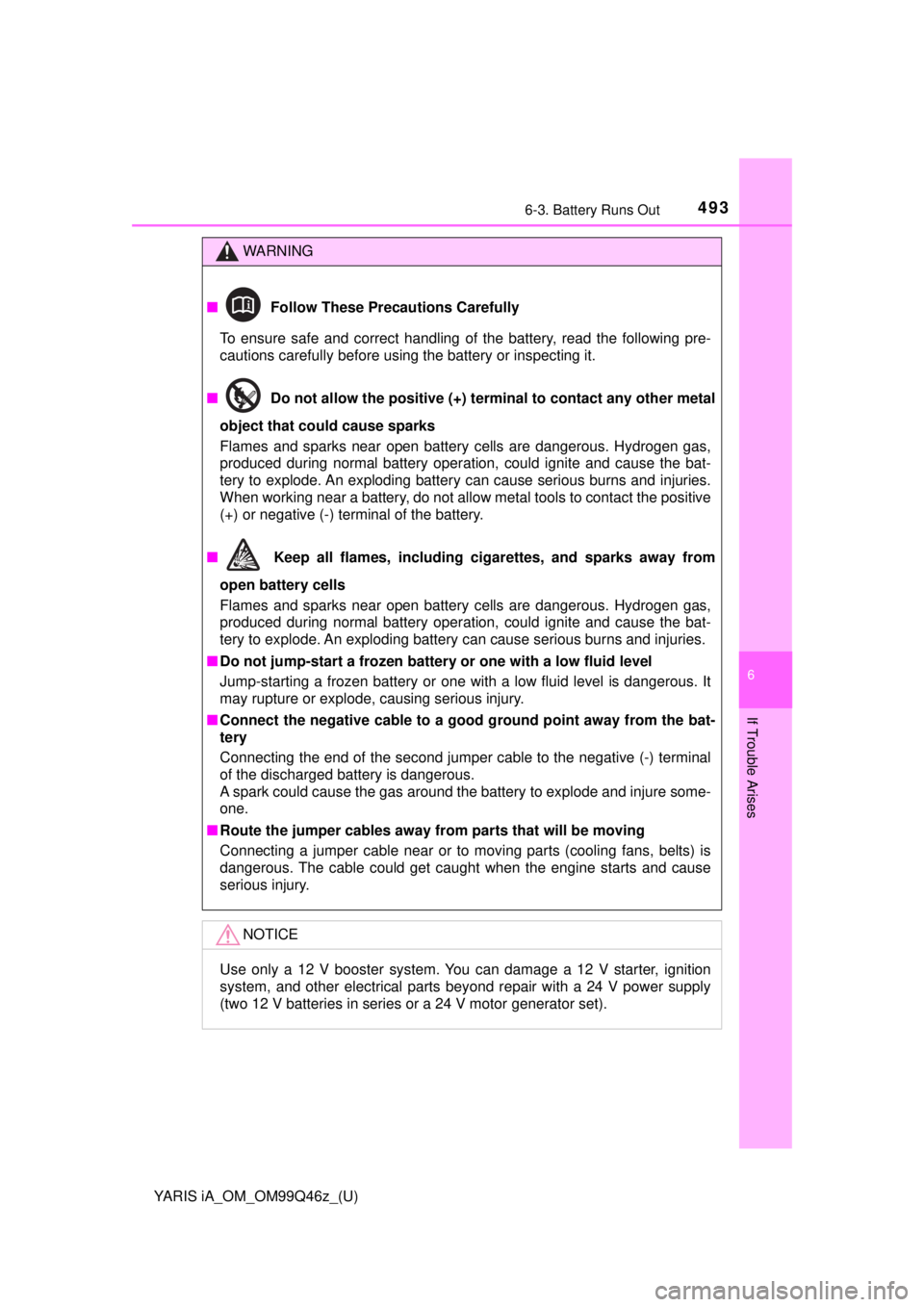
YARIS iA_OM_OM99Q46z_(U)
4936-3. Battery Runs Out
6
If Trouble Arises
WARNING
■ Follow These Precautions Carefully
To ensure safe and correct handling of the battery, read the following pre-
cautions carefully before using the battery or inspecting it.
■ Do not allow the positive (+) term inal to contact any other metal
object that could cause sparks
Flames and sparks near open battery cells are dangerous. Hydrogen gas,
produced during normal battery operation, could ignite and cause the bat-
tery to explode. An exploding battery can cause serious burns and injuries.
When working near a battery, do not allow metal tools to contact the positive
(+) or negative (-) terminal of the battery.
■ Keep all flames, including cigarettes, and sparks away from
open battery cells
Flames and sparks near open battery cells are dangerous. Hydrogen gas,
produced during normal battery operation, could ignite and cause the bat-
tery to explode. An exploding battery can cause serious burns and injuries.
■ Do not jump-start a frozen battery or one with a low fluid level
Jump-starting a frozen battery or one with a low fluid level is dangerous. It
may rupture or explode, causing serious injury.
■ Connect the negative cable to a good ground point away from the bat-
tery
Connecting the end of the second jumper cable to the negative (-) terminal
of the discharged battery is dangerous.
A spark could cause the gas around the battery to explode and injure some-
one.
■ Route the jumper cables away fr om parts that will be moving
Connecting a jumper cable near or to moving parts (cooling fans, belts) is
dangerous. The cable could get caught when the engine starts and cause
serious injury.
NOTICE
Use only a 12 V booster system. You can damage a 12 V starter, ignition
system, and other electrical parts beyond repair with a 24 V power supply
(two 12 V batteries in series or a 24 V motor generator set).
Page 495 of 576
495
YARIS iA_OM_OM99Q46z_(U)
6-4. Emergency Starting
6
If Trouble Arises
Push-Starting
Do not push-start your Toyota.
You cannot start a vehicle with an automatic transaxle by pushing it.
WARNING
■Never tow a vehicle to start it
Towing a vehicle to start it is dangerous. The vehicle being towed could
surge forward when its engine starts, causing the two vehicles to collide.
The occupants could be injured.
NOTICE
Do not push-start a vehicle that has a manual transaxle. It can damage the
emission control system.
Page 496 of 576

496
YARIS iA_OM_OM99Q46z_(U)
6-5. Overheating
Overheating
If the high engine coolant temperature warning light turns on:Drive safely to the side of the road and park off the right-of-way.
Put a vehicle with an automatic tr ansaxle in park (P), a manual tran-
saxle in neutral.
Apply the parking brake.
Turn off the air conditioner.
Check whether coolant or steam is escaping from the engine com-
partment.
If steam is coming from the engine compartment
Do not go near the front of the vehicle. Stop the engine.
Wait until the steam dissipates, then open the hood and start the
engine.
If neither coolant nor steam is escaping
Open the hood and idle the engine until it cools.
Make sure the cooling fan is operating, then turn off the engine after
the temperature has decreased.
When cool, check the coolant level.
If it is low, look for coolant leaks from the radiator and hoses.
■If you find a leak or other damage , or if coolant is still leaking:
Stop the engine and call your Toyota dealer.
Cooling fan
Cooling system cap
Coolant reservoir
If the high engine coolant temperature warning light turns on,
the vehicle loses power, or you hear a loud knocking or pinging
noise, the engine is probably too hot.
1
2
3
4
5
6
7
1
2
3
Page 497 of 576
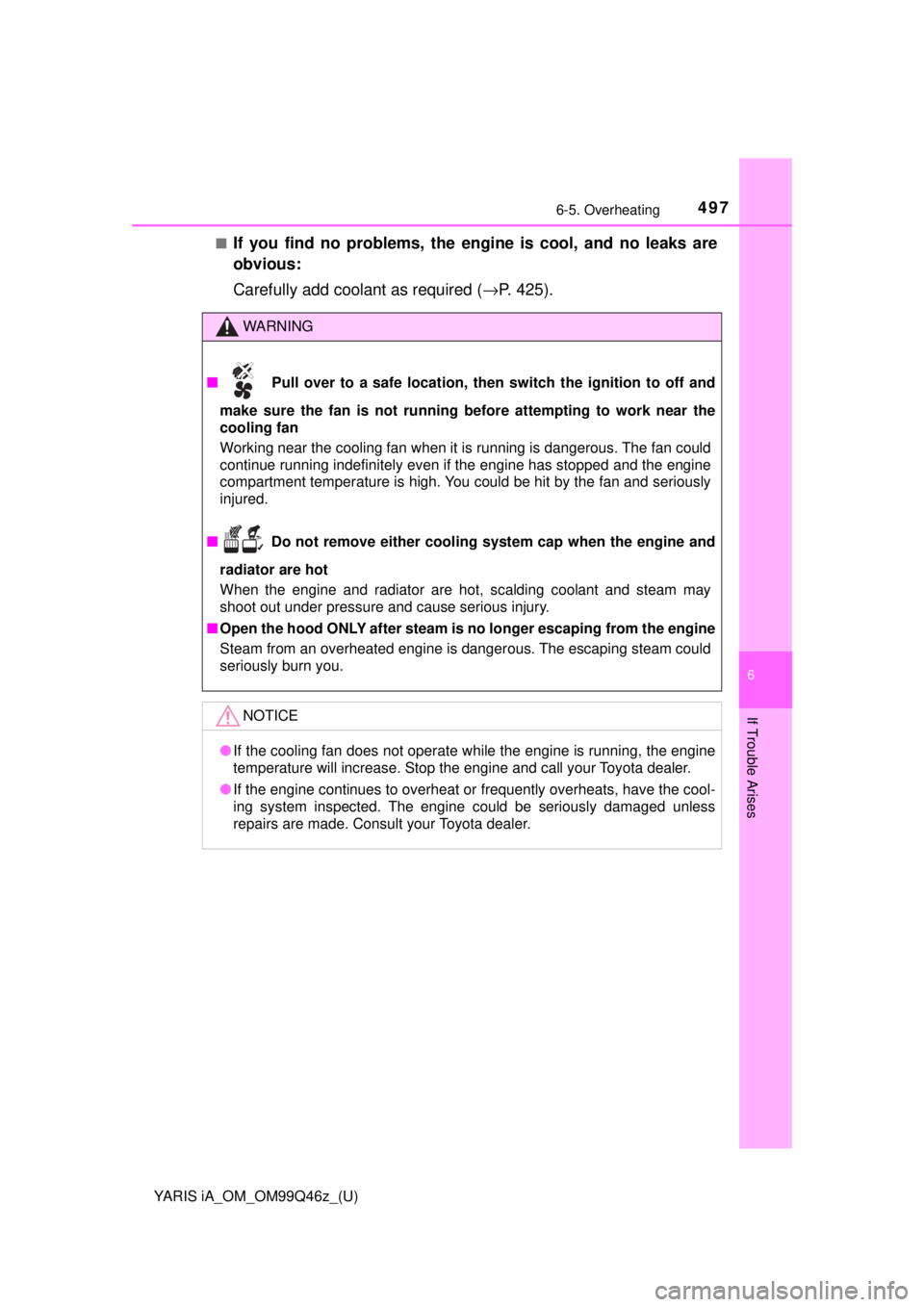
YARIS iA_OM_OM99Q46z_(U)
4976-5. Overheating
6
If Trouble Arises
■If you find no problems, the engine is cool, and no leaks are
obvious:
Carefully add coolant as required (→P. 425).
WARNING
■ Pull over to a safe location, then switch the ignition to off and
make sure the fan is not running befo re attempting to work near the
cooling fan
Working near the cooling fan when it is running is dangerous. The fan could
continue running indefinitely even if the engine has stopped and the engine
compartment temperature is high. You could be hit by the fan and seriously
injured.
■ Do not remove either cooling system cap when the engine and
radiator are hot
When the engine and radiator are hot, scalding coolant and steam may
shoot out under pressure and cause serious injury.
■ Open the hood ONLY after steam is no longer escaping from the engine
Steam from an overheated engine is dangerous. The escaping steam could
seriously burn you.
NOTICE
● If the cooling fan does not operate while the engine is running, the engine
temperature will increase. Stop the engine and call your Toyota dealer.
● If the engine continues to overheat or frequently overheats, have the cool-
ing system inspected. The engine could be seriously damaged unless
repairs are made. Consult your Toyota dealer.
Page 501 of 576
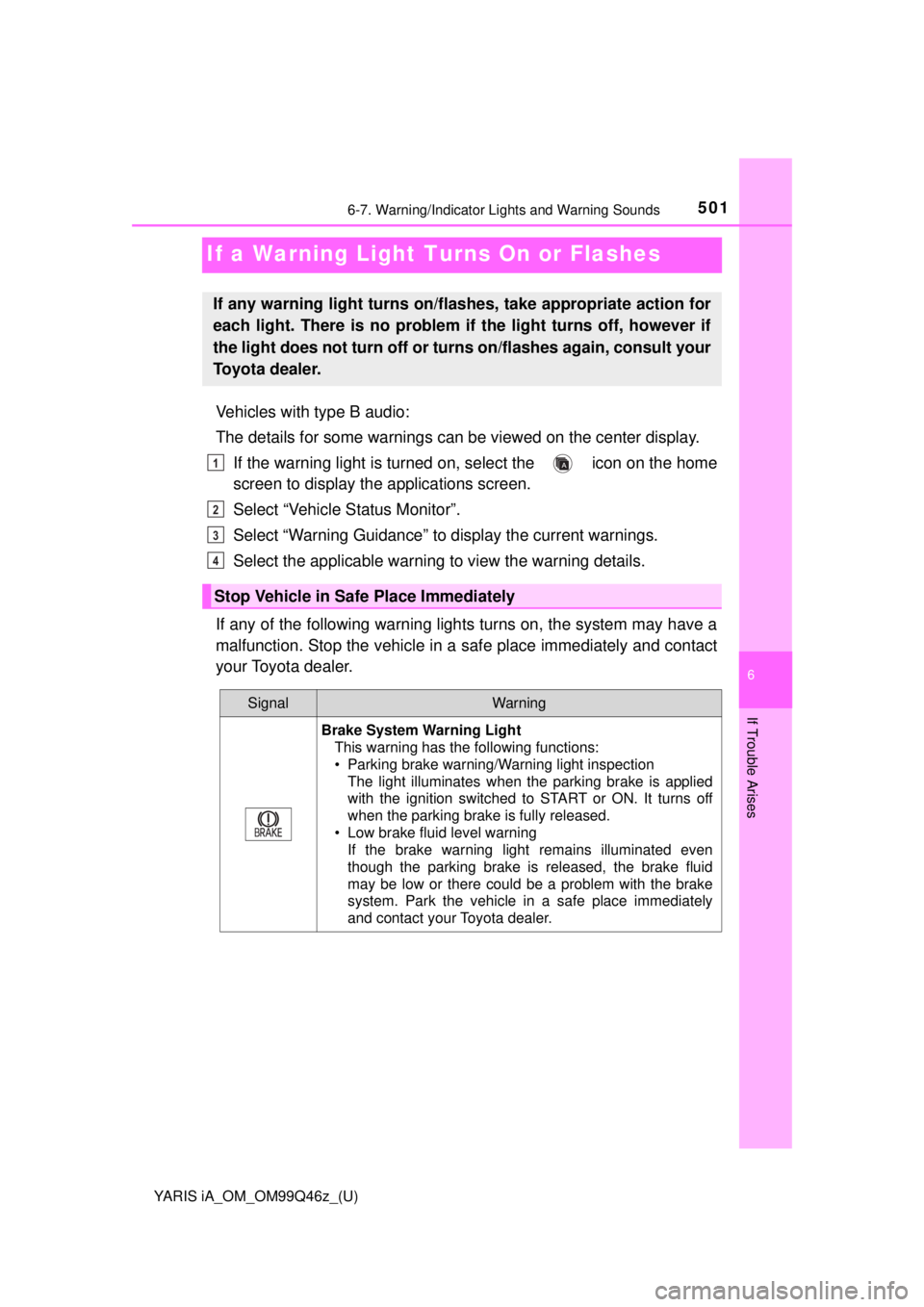
501
YARIS iA_OM_OM99Q46z_(U)
6-7. Warning/Indicator Lights and Warning Sounds
6
If Trouble Arises
If a Warning Light Turns On or Flashes
Vehicles with type B audio:
The details for some warnings can be viewed on the center display.
If the warning light is turned on, select the icon on the home
screen to display the applications screen.
Select “Vehicle Status Monitor”.
Select “Warning Guidance” to display the current warnings.
Select the applicable warning to view the warning details.
If any of the following warning lights turns on, the system may have a
malfunction. Stop the vehicle in a safe place immediately and contact
your Toyota dealer.
If any warning light turns on/flash es, take appropriate action for
each light. There is no problem if the light turns off, however if
the light does not turn off or turns on/flashes again, consult your
Toyota dealer.
Stop Vehicle in Safe Place Immediately
SignalWarning
Brake System Warning Light This warning has the following functions:
• Parking brake warning/Warning light inspection
The light illuminates when the parking brake is applied
with the ignition switched to START or ON. It turns off
when the parking brake is fully released.
• Low brake fluid level warning If the brake warning light remains illuminated even
though the parking brake is released, the brake fluid
may be low or there could be a problem with the brake
system. Park the vehicle in a safe place immediately
and contact your Toyota dealer.
1
2
3
4
Page 502 of 576
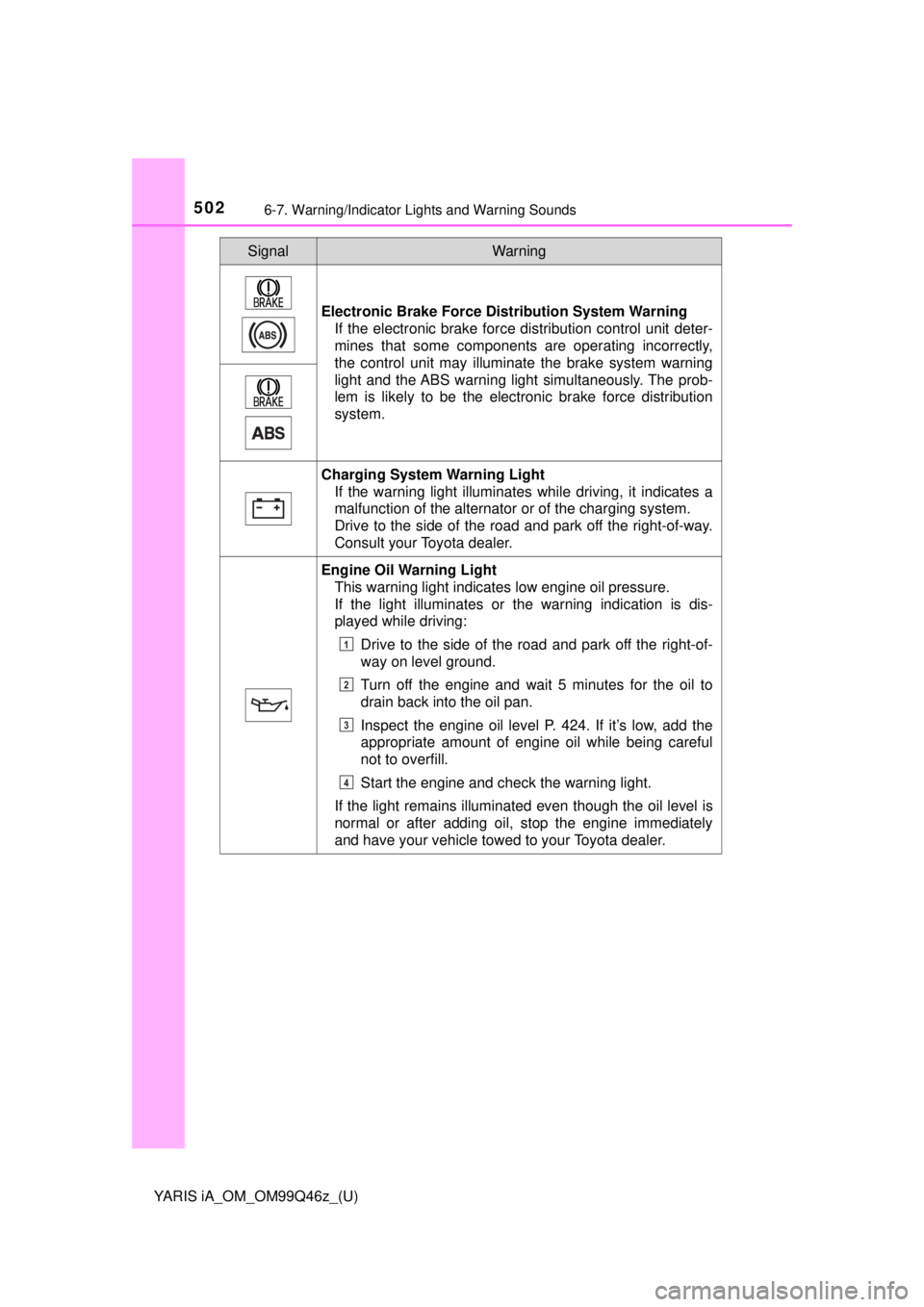
5026-7. Warning/Indicator Lights and Warning Sounds
YARIS iA_OM_OM99Q46z_(U)
Electronic Brake Force Distribution System Warning
If the electronic brake force distribution control unit deter-
mines that some components are operating incorrectly,
the control unit may illuminate the brake system warning
light and the ABS warning light simultaneously. The prob-
lem is likely to be the electronic brake force distribution
system.
Charging System Warning Light
If the warning light illuminates while driving, it indicates a
malfunction of the alternator or of the charging system.
Drive to the side of the road and park off the right-of-way.
Consult your Toyota dealer.
Engine Oil Warning LightThis warning light indicates low engine oil pressure.
If the light illuminates or the warning indication is dis-
played while driving:
Drive to the side of the road and park off the right-of-
way on level ground.
Turn off the engine and wait 5 minutes for the oil to
drain back into the oil pan.
Inspect the engine oil level P. 424. If it’s low, add the
appropriate amount of engine oil while being careful
not to overfill.
Start the engine and check the warning light.
If the light remains illuminated even though the oil level is
normal or after adding oil, stop the engine immediately
and have your vehicle towed to your Toyota dealer.
SignalWarning
1
2
3
4